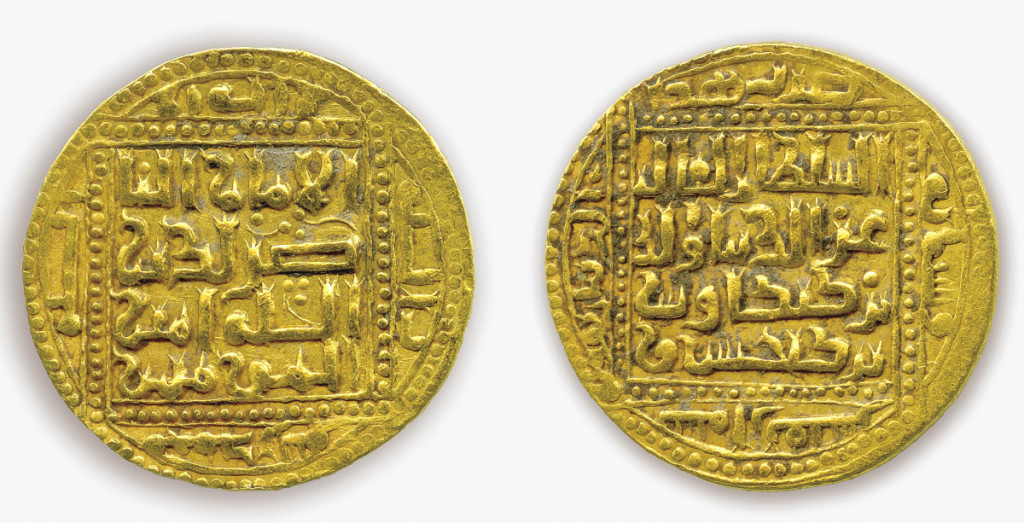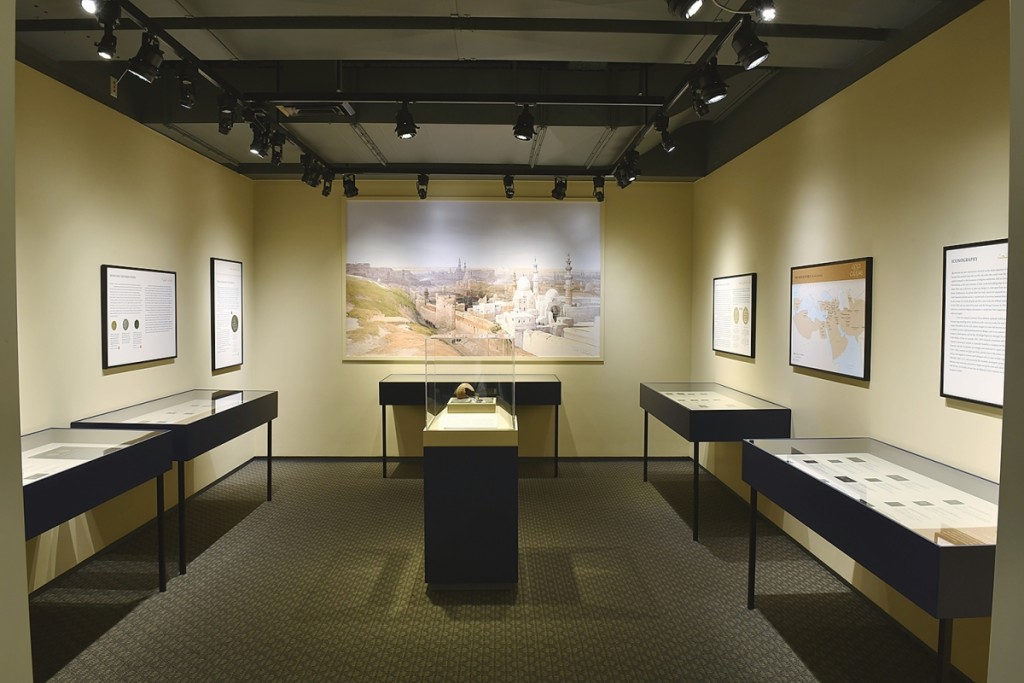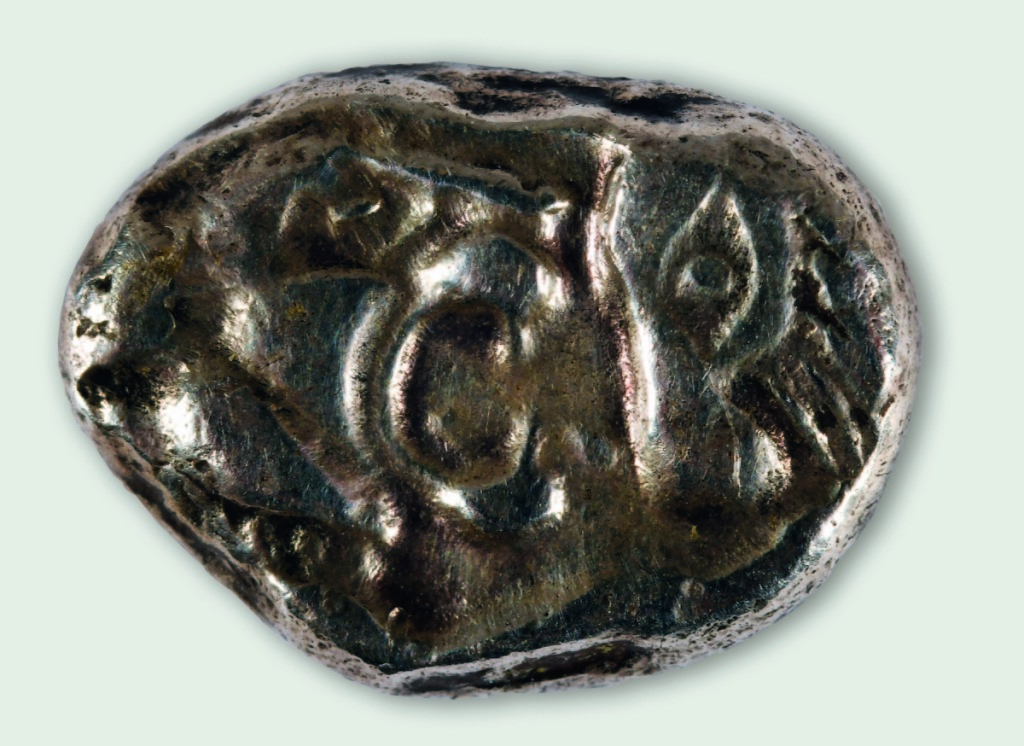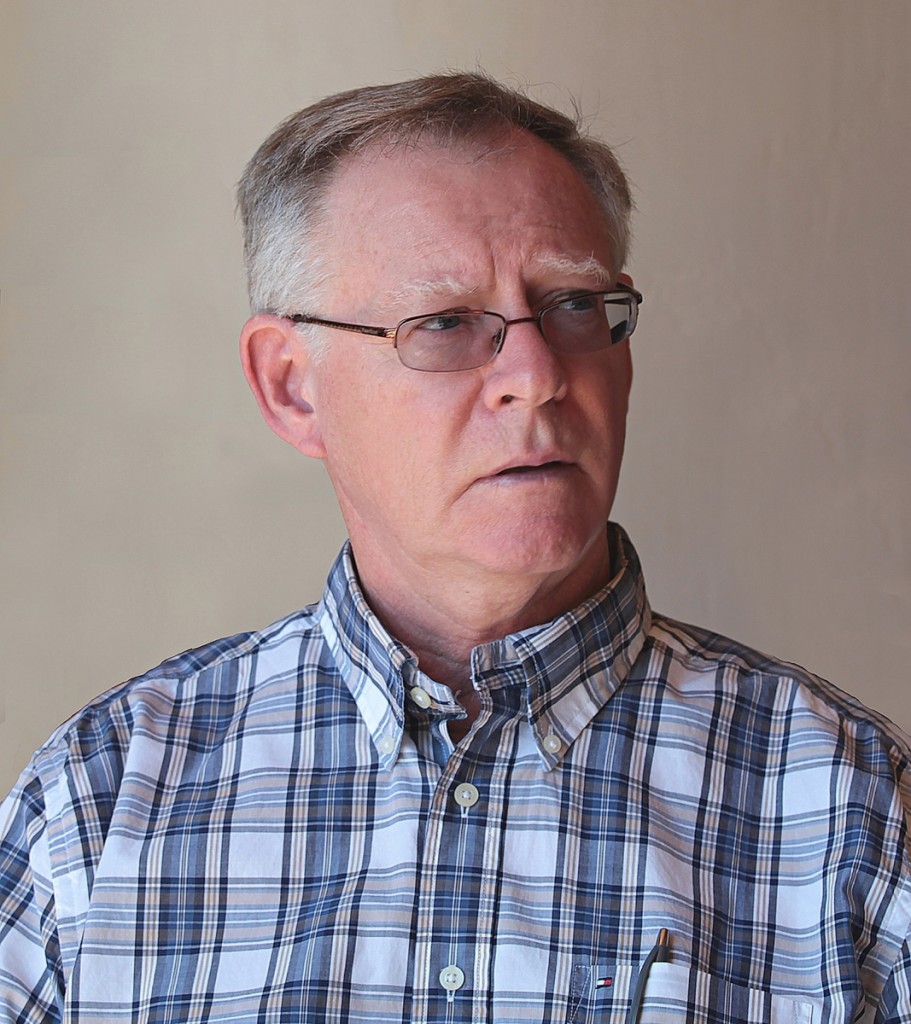
Gold dinar, Seljuk Dynasty of Rum or Anatolia (modern Turkey), circa 1217-18. Minted at Konya in central Turkey by Sultan Kay Kawus I (1211-20). Collection of the Hallie Ford Museum of Art, Willamette University, Salem, Ore., gift of Gary Leiser.
By James D Balestrieri
SALEM, ORE.- Collecting begins in passion, and my first crush, when I was quite young, was coins. A few friends of the family collected them, and I had a brother who sent coins back from his European travels, and I had an aunt in the antiques business who ran across the odd Liberty dime, and then I discovered another kid who collected. On occasion, even in the 1960s-70s, an Indian Head penny or a Buffalo nickel would pop up in change. Once, when I was digging for treasure in my backyard, I unearthed an 1898 Indian Head penny in very good condition. I still have that penny. What the collection meant wasn’t lost on me. I was interested in history and wondered whose hands these coins had passed through. I used to haunt the coin and stamp department at Gimbels and, one Easter, in my basket, a very well-worn penny from 1798 peeked out around the chocolate eggs wrapped in waxed paper. I had longed for a coin that George Washington might have touched, and there it was, on a bed of sponge in its plastic box, with the word “Liberty” flowing over the faint profile of Liberty, a young woman with hair flowing in a free, very un-Eighteenth Century way, over the date. Washington died in 1799. The Easter Bunny had heard me. I still have that penny.
Other passions craved indulgence and my odd collection of Italian lire, French centimes, Standing Liberty quarters without dates, and big British pennies – old pence – sat there, quietly patinating.
I never lost my interest in history, however, and as my interest in art has grown, it turns out that numismatics, as the study of coins is called, combines them in fascinating and enduring ways.

Installation photograph, “Gold Of The Caliphs: Medieval Islamic Coins From The Gary Leiser Collection Of The Hallie Ford Museum Of Art,” on through August 14. Courtesy of the Hallie Ford Museum of Art. Photo by Dale Peterson.
“Gold of the Caliphs: Medieval Islamic Coins from the Gary Leiser Collection of the Hallie Ford Museum of Art,” now on view at the Hallie Ford Museum at Willamette University in Salem, Ore., reminds us that a passion to collect can grow into a lifetime of learning, and that collections offer special, sensory insights into history. Leiser’s collection of Islamic coins, the largest of its kind on the West Coast, and the most comprehensive of its kind that is readily available to students and the public, illuminates not only the rise of the Islamic faith, but also the competition between the Islamic world (and the rivalries within it) and the Byzantine Empire as well as the cultural struggles of the Mongols as they sought to maintain control over the Islamic world once they had conquered the greater part of it in 1258 CE.
Gary Leiser studied Arabic in Lebanon as an undergraduate. While there, he also traveled – hitchhiking mostly – through Syria, Jordan, Egypt, Libya and Tunisia. Thinking his would be an academic path, he began to haunt bazaars and antique shops, looking for coins that would serve as show-and-tell items in the classes he would teach. Fate had other plans, and Leiser ended up working for the US Department of Defense in Ankara, Turkey, as an interpreter and Air Force historian. Still, Leiser haunted the shops and his skill at reading Medieval Arabic inscriptions – inscriptions the shop owners often could not read – made him a collector to call when a new hoard appeared on the market. The Gary Leiser Collection is a lasting tribute to the academic that never was, a tribute that will do the teaching for him.
In speaking with Leiser, I wondered why the early Islamic coins looked so much like the coins of Byzantium and Persia. The Hijaz, he informed me, where Islam was born, in western Arabia, had no coinage of its own. The people there used Byzantine and Persian coins. Thus, the first Islamic coins are imitations and their denominations are adaptations of Greek and Roman names: drachm becomes dirham; denarius becomes dinar; follis becomes fals. Despite this, the inscriptions on Islamic coins offer an opportunity for Baghdad, as Leiser puts it, to counter Constantinople. Coins become a medium for Islam to refute the Christian doctrine of the Trinity, reading, for example, “There is no god but God alone, He has no partner,” or “God is one. God is eternal. He did not beget and He was not begotten.”
Later, when the rivalry shifts to Sunni against Shi’ite, coins announce and reflect the difference in their respective approaches to the faith. Under the Mongols, inscriptions on the first coins are in Arabic on one side and in Uighur – the written language adopted by the Mongols, who had none of their own – on the other. Still later, the inscriptions on the coins shift from Sunni to Shi’ite as the Khans, who converted to Islam, belonged to one or the other denomination, and as the Mongols sought to placate both branches and keep abreast of shifting ideological winds.
You naturally pick favorites in a collection like Leiser’s, and I found the “Lion and Sun” coins, struck by Seljuk Sultan of Rum or Anatolia (Central Turkey), Ghiyath al-Din Kay Khusraw II (r 1237-1246) to be not only beautiful works of art, but to have attached to them a romantic tale, which may or may not be true. As the brochure to the collection states: “The Christian historian Bar Hebraeus (d 1286) says, ‘The Sultan married the daughter of the king of Georgia and was passionately in love with her. He was so madly in love with her that he wanted an image of her on his dirhams, but he was advised to depict the image of a lion above which was a sun in order to refer to his ascendant star, and by this means his goal was achieved.’ Based on this, the great Austrian historian of the Ottoman Empire, Joseph von Hammer-Purgstall (d 1856) believed the lion symbolized the sultan and the sun symbolized his Georgian bride.” As a tragic coda, the Sultan was killed by one of the lions he kept after the Mongols defeated his army and conquered him in 1243. The tale is all the more romantic because of its fragmentary nature. Was the love between the Sultan and the daughter of the king of Georgia taboo? Are the coins a premonition of his ill-starred end? According to Leiser, his “Lion and Sun” coins were part of a hoard unearthed, probably somewhere in Turkey. In a world without banks, money was often buried in earthenware jars. Hoards emerge all over the world “as treasure troves for archaeologists and historians.”
Another coin, one that predates Islam by centuries, is of particular interest. The world’s oldest coins, according to Herodotus, were issued in the kingdom of Lydia, on what is now the Aegean coast of Turkey, by King Alyattes who reigned from 560-547 BCE. A little “glob of electrum,” as Leiser refers to the example in his collection – electrum is an alloy of silver and gold – stamped with a lion on one side, this, the invention of currency as a medium of exchange was nothing short of revolutionary. Standardized coinage, as Leiser says, “minimized barter and opened opportunities for caravans” and trade across boundaries. The world has never been the same since.

World’s oldest coin, circa 600 BCE. Minted in Ancient Lydia by King Alyattes (619-560 BCE). Collection of the Hallie Ford Museum of Art, Willamette University, Salem, Ore., promised gift from Gary Leiser.
Leiser acquired his Lydian coin on a trip to Southwest Anatolia, the Aegean coast of Turkey, a place, he said, “with interesting ruins, good food and good beaches.” A farmer approached him, held out his hand and opened it to reveal the Lydian coin. He said he’d found it in his field and asked if Leiser had interest. He did.
Minting was an imperfect science, and Leiser’s collection includes some glass coin weights that were used to ensure that coins had the proper value of metal. Then as now, times could change, and there were always those who sought to game the system. In Ancient Rome, for example, a thin coating of silver often covered a core flan of bronze, and during the time of the Crusades, Christians, in an attempt to break into the rich economies of the Holy Land, often minted imitations of Islamic coins, such as Leiser’s gold dinar of the Fatimid Dynasty.
I asked Leiser whether it would be possible to amass a collection today as he did in the 1980s and after. To my surprise, he said yes, and added that the key is to move around and get to know the antiques dealers. Passion and persistence pay off.
In another surprise, collecting ancient and medieval coins doesn’t have to be all that expensive. To purchase gold coins, or to collect only the best examples is, of course, costly. But coins, once they took hold of the economic imagination, were minted in the millions. One of the reasons for this emerges from my reading in Roman history. Let’s say you were declared or that you had the audacity to declare yourself the next Emperor of Rome – your lifespan would shorten considerably, but life is full of tradeoffs like that, right? Now you’re the Emperor. What do you do first? Race to the nearest mint. Why? To get your name and likeness on as many coins as possible. If you’re short on time, forget the likeness. Just use the last poor guy’s face. Who would know? From China and India to the Iberian Peninsula, from Africa to the Arctic, coins are the political campaign buttons of the ancient and medieval worlds, minus the elections.
For a relatively small sum, you can hold a coin of Constantine I in one hand and a coin of his co-emperor Licinius, whose navy and reign Constantine ended in the Bosporus just off the city of Byzantium (that would soon become known as Constantinople), in the other.
I look at the obverse of my 1798 penny, at the silhouette of Liberty, just under the word “Liberty” and then at “United States of America,” rubbed and worn almost away on the reverse. Is my penny a commemorative, a campaign button, or a promise not yet fulfilled? I think of what it took to make it, of where it has been, circulating through time, of what time has done to it, and even though I no longer collect coins, I know I would never sell it.























